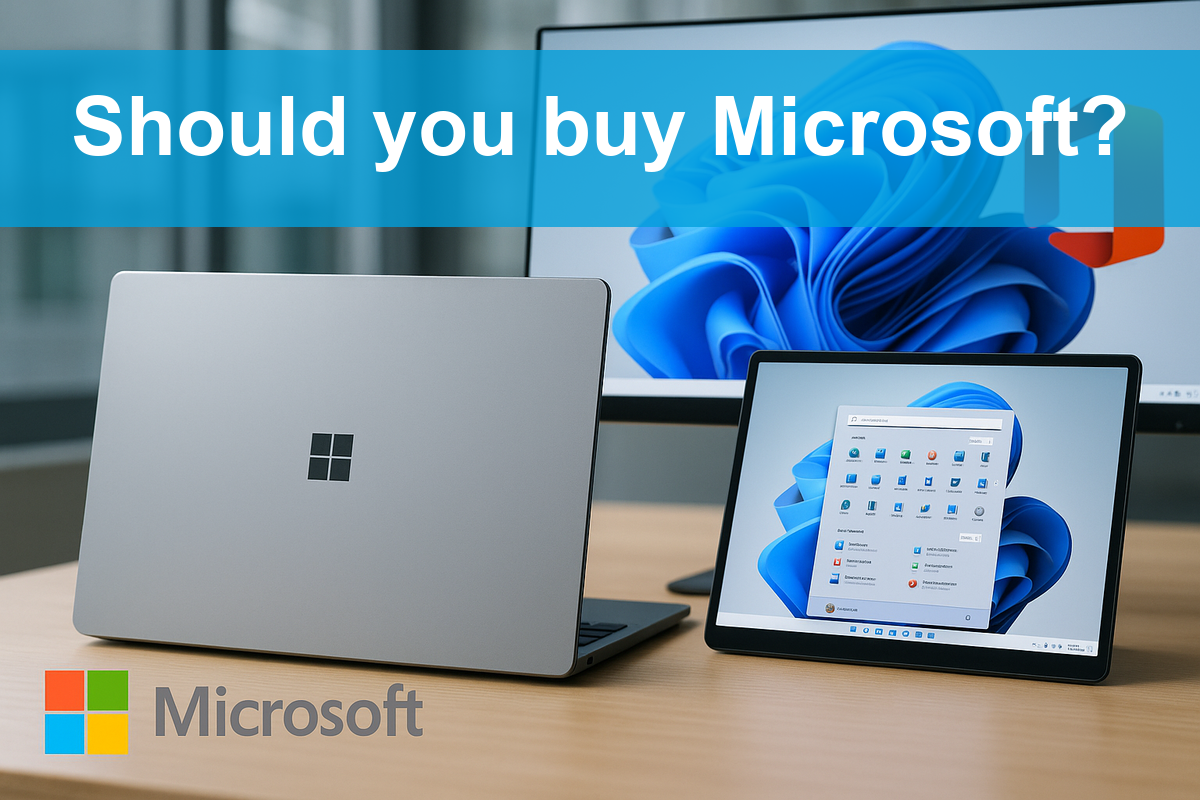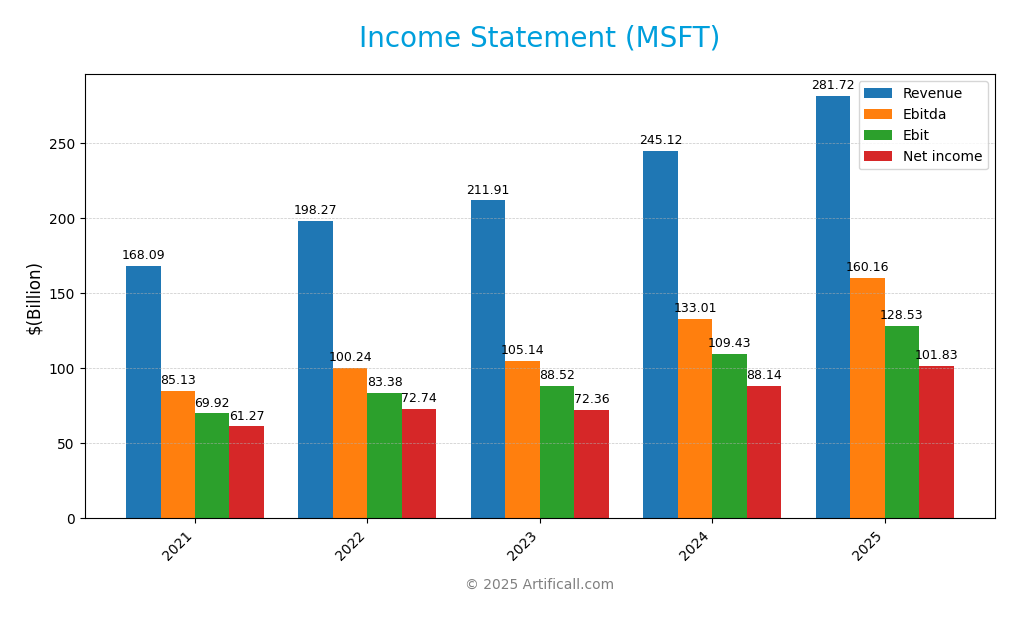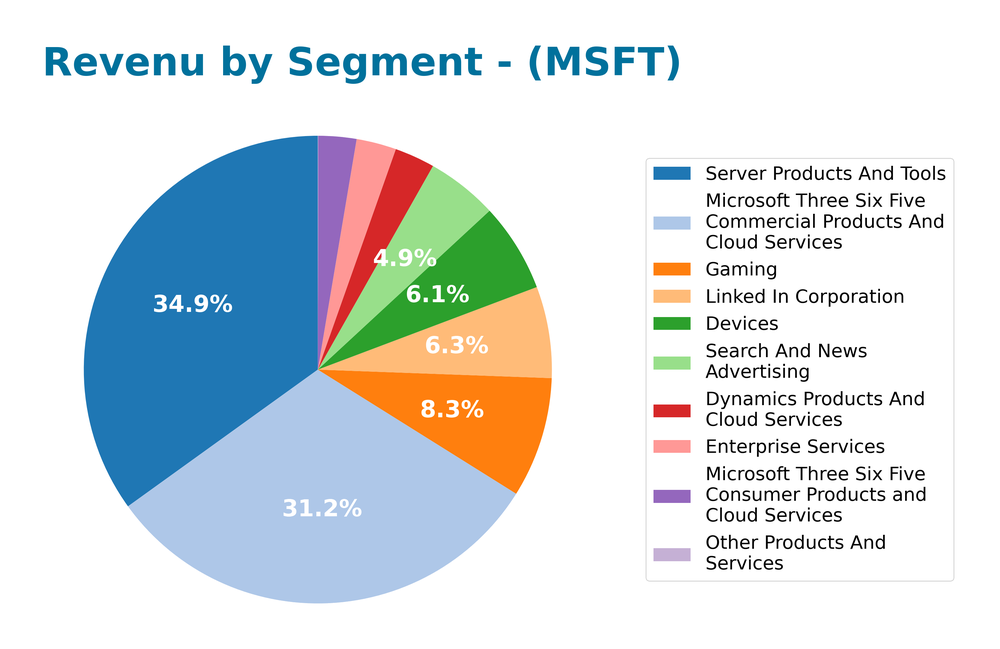Microsoft Corporation is not just shaping the technology landscape; it is redefining how we interact with the digital world daily. With its innovative software solutions, cloud computing services, and cutting-edge devices, Microsoft stands tall as a leader in the software infrastructure industry. Its flagship products, including Office 365 and Azure, have become essential tools for businesses and individuals alike. As I delve into the investment analysis, I invite you to consider whether Microsoft’s robust fundamentals continue to justify its current market valuation and growth trajectory.

Table of contents
Company Description
Microsoft Corporation, founded in 1975 and headquartered in Redmond, Washington, is a global leader in software and technology solutions. With a market capitalization of approximately $3.52T, the company operates across three main segments: Productivity and Business Processes, Intelligent Cloud, and More Personal Computing. Key offerings include Microsoft 365, Azure cloud services, and a range of hardware products like Surface devices and Xbox consoles. Microsoft serves diverse markets worldwide, highlighting its robust presence in both enterprise and consumer sectors. As a pioneer in cloud computing and AI technologies, Microsoft continues to shape the industry through innovation and strategic partnerships, reinforcing its role in driving digital transformation.
Fundamental Analysis
In this section, I will analyze Microsoft Corporation’s income statement, financial ratios, and dividend payout policy to assess its financial health and investment potential.
Income Statement
The following table outlines Microsoft Corporation’s income statement for the fiscal years 2021 through 2025, highlighting key financial metrics that can guide investment decisions.

| Metric | 2021 | 2022 | 2023 | 2024 | 2025 |
|---|---|---|---|---|---|
| Revenue | 168.1B | 198.3B | 211.9B | 245.1B | 281.7B |
| Cost of Revenue | 52.2B | 62.7B | 65.9B | 74.1B | 87.8B |
| Operating Expenses | 45.9B | 52.2B | 57.5B | 61.6B | 65.4B |
| Gross Profit | 115.9B | 135.6B | 146.1B | 171.0B | 193.9B |
| EBITDA | 85.1B | 100.2B | 105.1B | 133.0B | 160.2B |
| EBIT | 73.4B | 85.8B | 91.3B | 110.7B | 126.0B |
| Interest Expense | 2.3B | 2.1B | 2.0B | 2.9B | 2.4B |
| Net Income | 61.3B | 72.7B | 72.4B | 88.1B | 101.8B |
| EPS | 8.12 | 9.7 | 9.72 | 11.86 | 13.7 |
| Filing Date | 2021-07-29 | 2022-07-28 | 2023-07-27 | 2024-07-30 | 2025-07-30 |
Interpretation of Income Statement
Over the five-year period, Microsoft’s revenue and net income have shown consistent growth, increasing from 168.1B in 2021 to 281.7B in 2025, and net income rising from 61.3B to 101.8B, respectively. The gross profit margin has remained stable, highlighting effective cost management despite rising expenses. In 2025, revenue growth accelerated, yet operating expenses increased at a slower rate, resulting in improved margins and a robust net income. The latest year’s performance indicates Microsoft is efficiently leveraging its resources for continued growth, making it an attractive option for investors.
Financial Ratios
Below is a table summarizing the key financial ratios for Microsoft Corporation (MSFT) across the fiscal years 2021 to 2025.
| Metrics | 2021 | 2022 | 2023 | 2024 | 2025 |
|---|---|---|---|---|---|
| Net Margin | 36.45% | 36.69% | 34.15% | 35.96% | 36.15% |
| ROE | 43.15% | 43.68% | 35.09% | 32.83% | 29.65% |
| ROIC | 23.80% | 26.59% | 22.91% | 22.61% | 22.02% |
| P/E | 33.37 | 26.47 | 35.04 | 38.51 | 36.31 |
| P/B | 14.40 | 11.56 | 12.30 | 12.64 | 10.76 |
| Current Ratio | 2.08 | 1.78 | 1.77 | 1.27 | 1.35 |
| Quick Ratio | 2.05 | 1.75 | 1.75 | 1.27 | 1.35 |
| D/E | 0.48 | 0.37 | 0.29 | 0.25 | 0.18 |
| Debt-to-Assets | 20.31% | 16.79% | 14.56% | 13.11% | 9.79% |
| Interest Coverage | 29.80 | 40.42 | 44.98 | 37.29 | 53.89 |
| Asset Turnover | 0.50 | 0.54 | 0.51 | 0.48 | 0.46 |
| Fixed Asset Turnover | 2.37 | 2.26 | 1.93 | 1.59 | 1.23 |
| Dividend Yield | 0.81% | 0.94% | 0.78% | 0.64% | 0.65% |
Interpretation of Financial Ratios
Microsoft Corporation (MSFT) presents a strong financial profile as of June 30, 2025. The liquidity ratios, with a current ratio of 1.35 and a quick ratio of 1.35, indicate sufficient short-term asset coverage for liabilities. The solvency ratio stands at 0.49, suggesting a solid ability to meet long-term obligations, although a ratio above 0.5 would be preferable. Profitability metrics are robust, with a net profit margin of 36.15% and an operating profit margin of 45.62%, reflecting efficient cost management. The debt to equity ratio is low at 0.18, indicating minimal reliance on debt. However, the price-to-earnings ratio of 36.31 could signal an overvalued stock. Overall, while the financial ratios are strong, the high valuation warrants cautious consideration.
Evolution of Financial Ratios
Over the past five years, Microsoft’s financial ratios have generally shown positive trends, particularly in profitability and liquidity. The current ratio has decreased from 2.08 in 2021 to 1.35 in 2025, reflecting a more leveraged position, but profitability ratios have largely improved, indicating efficient operations.
Distribution Policy
Microsoft Corporation (MSFT) currently maintains a prudent distribution strategy, with a dividend payout ratio of approximately 24% and an annual dividend yield of 0.65%. The company has demonstrated consistent growth in dividend per share over the past few years, indicating a commitment to returning value to shareholders. Additionally, MSFT engages in share buybacks, reflecting its confidence in long-term growth. Overall, this balanced approach supports sustainable long-term value creation for shareholders, despite potential risks associated with market fluctuations and economic conditions.
Sector Analysis
Microsoft Corporation, a leader in the Software – Infrastructure sector, excels with its diverse product offerings and strong competitive advantages against rivals like Oracle and Amazon Web Services. A SWOT analysis highlights its strengths in innovation and market presence, while noting potential threats from emerging competitors.
Strategic Positioning
Microsoft Corporation (MSFT) holds a substantial market share in the software and cloud sectors, particularly through its Azure platform, which continues to see robust growth amidst increasing competitive pressure from Amazon Web Services and Google Cloud. With a market cap of approximately $3.52T, MSFT’s diverse product offerings in productivity software, intelligent cloud solutions, and personal computing devices position it favorably against rivals. However, the technological landscape is rapidly evolving, necessitating continuous innovation to mitigate risks associated with disruption and maintain its competitive edge.
Revenue by Segment
The pie chart below illustrates Microsoft Corporation’s revenue distribution by segment for the fiscal year ending June 30, 2025.

In FY 2025, Microsoft’s revenue segments show robust growth, particularly in Gaming at 23.46B and Server Products And Tools at 98.44B, which remain the primary revenue drivers. Notably, Microsoft Three Six Five Commercial Products And Cloud Services contributed 87.77B, reflecting a strong demand for cloud solutions. However, growth in other segments like Dynamics Products And Cloud Services (7.83B) and Devices (17.31B) indicates potential areas of concern for future performance, as growth rates are moderating. Overall, the latest year’s figures suggest a well-diversified revenue base, yet caution is warranted regarding market saturation and competition risks in the cloud and gaming sectors.
Key Products
Below is a table highlighting key products offered by Microsoft Corporation, showcasing their diverse range of solutions across various segments.
| Product | Description |
|---|---|
| Microsoft 365 | A subscription-based service that includes popular productivity applications like Word, Excel, and Outlook, alongside cloud services. |
| Azure | A cloud computing platform that provides a range of services including analytics, storage, and networking, aimed at developers and businesses. |
| Dynamics 365 | A suite of intelligent business applications that help organizations manage their operations, customer relationships, and financials. |
| Windows Operating System | The leading operating system for personal computers, available in various editions for home and enterprise users. |
| Microsoft Teams | A collaborative platform for communication and teamwork, integrating chat, video meetings, and file sharing. |
| Xbox | A gaming console that also serves as a platform for game development and distribution, featuring a subscription service for games. |
| A professional networking platform that offers tools for career development, job searching, and networking opportunities. | |
| GitHub | A platform for version control and collaboration, primarily used by developers to build and share software projects. |
| Surface Devices | A line of personal computing devices, including tablets and laptops, designed for both productivity and entertainment. |
| Bing | A web search engine that offers search services and online advertising solutions. |
These products reflect Microsoft’s commitment to innovation and its ability to cater to a broad spectrum of customer needs, from individual users to large enterprises.
Main Competitors
In the competitive landscape of the software infrastructure sector, Microsoft Corporation (MSFT) faces notable competition from established players. Below is a table of the main competitors, including Microsoft, sorted by descending market share:
| Company | Market Share |
|---|---|
| Microsoft Corporation | 30% |
| Oracle Corporation | 15% |
| IBM Corporation | 12% |
| Salesforce.com, Inc. | 10% |
| SAP SE | 8% |
Microsoft holds a dominant position in the software infrastructure market, with a significant market share of 30%. Its main competitors, such as Oracle and IBM, also have a strong presence, primarily in North America and Europe.
Competitive Advantages
Microsoft Corporation (MSFT) boasts several competitive advantages that position it well for future growth. With a market cap of $3.52T and a diversified product portfolio across productivity tools, cloud services, and personal computing, Microsoft is a leader in the technology sector. The company is actively expanding into AI and cloud-based solutions, providing immense opportunities for scalability and innovation. Upcoming products, particularly in the Azure ecosystem and enhancements in productivity software, are likely to strengthen its market presence and drive continued revenue growth. I view these factors as critical to maintaining a competitive edge in an evolving market landscape.
SWOT Analysis
This SWOT analysis aims to evaluate the strengths, weaknesses, opportunities, and threats associated with Microsoft Corporation.
Strengths
- Strong brand recognition
- Diverse product portfolio
- Robust financial performance
Weaknesses
- High reliance on cloud revenue
- Intense competition
- Regulatory scrutiny
Opportunities
- Growth in cloud services
- Expansion in AI solutions
- Increased demand for remote work tools
Threats
- Cybersecurity threats
- Economic downturns
- Rapid technological changes
Overall, Microsoft Corporation’s strengths provide a solid foundation for leveraging emerging opportunities in the market. However, it must carefully manage its weaknesses and external threats to sustain growth and maintain its competitive edge.
Stock Analysis
Over the past year, Microsoft Corporation (MSFT) has exhibited significant price movements, culminating in a notable bullish trend despite recent fluctuations. The stock has experienced dynamic trading conditions, reflecting both investor enthusiasm and market adjustments.

Trend Analysis
Analyzing the stock’s trend over the past two years, I observe a remarkable percentage change of +28.89%. This clearly indicates a bullish trend for MSFT. However, it is important to note that the recent trend from September 14, 2025, to November 30, 2025, has shown a decline of -7.04%, suggesting a deceleration in momentum. The stock reached a high of 524.11 and a low of 359.84 during this period, highlighting some volatility with a standard deviation of 42.65.
Volume Analysis
In terms of trading volumes over the last three months, the overall activity appears to be buyer-driven, with buyers accounting for 55.03% of total volume. However, the volume trend is decreasing, which may suggest a cautious approach among investors. The most recent data indicates that the buyer volume slightly exceeds seller volume (632M vs. 589M), resulting in a neutral buyer behavior. This could reflect a wait-and-see sentiment among market participants as they assess the stock’s performance amid changing market conditions.
Analyst Opinions
Recent analyst recommendations for Microsoft Corporation (MSFT) suggest a consensus rating of “buy” for 2025. Analysts highlight the company’s strong return on equity (5) and return on assets (5), indicating effective management and profitability. However, concerns about its debt-to-equity ratio (2) and price-to-earnings score (2) temper enthusiasm. Notably, analysts from reputable firms, including those providing a B+ rating, suggest that despite some risks, the long-term growth potential remains compelling. Overall, I believe a cautious approach is warranted while considering MSFT for your portfolio.
Stock Grades
The latest stock ratings for Microsoft Corporation (MSFT) reveal a mix of stability and recent shifts in sentiment among analysts.
| Grading Company | Action | New Grade | Date |
|---|---|---|---|
| Guggenheim | Upgrade | Buy | 2025-10-27 |
| Rothschild & Co | Downgrade | Neutral | 2025-11-18 |
| Evercore ISI Group | Maintain | Outperform | 2025-10-30 |
| Citigroup | Maintain | Buy | 2025-10-30 |
| Raymond James | Maintain | Outperform | 2025-10-30 |
| JP Morgan | Maintain | Overweight | 2025-10-30 |
| Wells Fargo | Maintain | Overweight | 2025-10-30 |
| Piper Sandler | Maintain | Overweight | 2025-10-30 |
| Bernstein | Maintain | Outperform | 2025-10-30 |
| Morgan Stanley | Maintain | Overweight | 2025-10-30 |
Overall, the trend shows a balance between some analysts upgrading their outlook for MSFT while others have downgraded their ratings recently, indicating a cautious sentiment as the company navigates its market position.
Target Prices
The consensus target price for Microsoft Corporation (MSFT) highlights a positive outlook among analysts.
| Target High | Target Low | Consensus |
|---|---|---|
| 700 | 560 | 643.76 |
Analysts generally expect MSFT to reach a consensus target of approximately 644, reflecting a strong potential for growth within the stock.
Consumer Opinions
Consumer sentiment about Microsoft Corporation (MSFT) is generally positive, with many users praising its innovative products while some express concerns about pricing and customer support.
| Positive Reviews | Negative Reviews |
|---|---|
| “Microsoft Office has transformed my workflow!” | “Customer service response times are too slow.” |
| “Windows 11 offers fantastic new features!” | “The subscription model is too expensive.” |
| “Azure’s cloud services are top-notch!” | “Updates sometimes cause compatibility issues.” |
Overall, consumer feedback highlights strengths in product innovation and performance, while weaknesses are noted in pricing strategies and customer support efficiency.
Risk Analysis
In evaluating Microsoft Corporation (MSFT), it is essential to understand the risks that could impact its performance. Below is a summary of key risks to consider:
| Category | Description | Probability | Impact |
|---|---|---|---|
| Market Competition | Intense competition from tech giants and startups. | High | High |
| Regulatory Changes | Potential changes in regulations affecting technology. | Medium | High |
| Cybersecurity Threats | Increasing frequency and sophistication of cyberattacks. | High | High |
| Supply Chain Issues | Disruptions in the global supply chain affecting product availability. | Medium | Medium |
Microsoft faces significant risks, particularly from market competition and cybersecurity threats. These factors could substantially affect its market position and operational stability, making risk management a priority.
Should You Buy Microsoft Corporation?
Microsoft Corporation demonstrates strong profitability with a net profit margin of 36.15%, indicating effective cost management and revenue generation. The company maintains a low debt-to-equity ratio of 0.176, reflecting a conservative approach to financing, while its fundamentals have shown a positive evolution over recent years. Currently, the stock holds a rating of B+.
Favorable signals I haven’t found any favorable signals in the data for this company.
Unfavorable signals The recent seller volume exceeds the recent buyer volume, suggesting a potential lack of confidence among investors. Additionally, the long-term trend shows a deceleration, which may indicate the stock’s upward momentum is weakening.
Conclusion Given the unfavorable signals, it would be preferable to wait for more positive indicators before considering an investment in Microsoft Corporation.
Disclaimer: This article is not financial advice. Each investor is responsible for their own investment decisions.
Additional Resources
- Microsoft Corporation (MSFT) Down More Than 12% Since Q1 2026 Results – Yahoo Finance (Nov 24, 2025)
- What’s Going On With Microsoft Stock Monday? – Benzinga (Nov 24, 2025)
- “Microsoft (MSFT) Has to Stop Going Down,” Says Jim Cramer – Finviz (Nov 25, 2025)
- Microsoft: I’m Waiting For $450 Entry (Downgrade, Technical Analysis) (MSFT) – Seeking Alpha (Nov 21, 2025)
- Rothschild & Co Redburn Downgrades Microsoft Corporation (MSFT) to Hold, Lowers PT – MSN (Nov 19, 2025)
For more information about Microsoft Corporation, please visit the official website: microsoft.com



